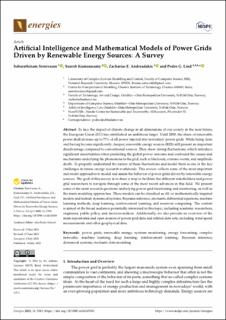| dc.description.abstract | To face the impact of climate change in all dimensions of our society in the near future, the European Union (EU) has established an ambitious target. Until 2050, the share of renewable power shall increase up to 75% of all power injected into nowadays’ power grids. While being clean and having become significantly cheaper, renewable energy sources (RES) still present an important disadvantage compared to conventional sources. They show strong fluctuations, which introduce significant uncertainties when predicting the global power outcome and confound the causes and mechanisms underlying the phenomena in the grid, such as blackouts, extreme events, and amplitude death. To properly understand the nature of these fluctuations and model them is one of the key challenges in future energy research worldwide. This review collects some of the most important and recent approaches to model and assess the behavior of power grids driven by renewable energy sources. The goal of this survey is to draw a map to facilitate the different stakeholders and power grid researchers to navigate through some of the most recent advances in this field. We present some of the main research questions underlying power grid functioning and monitoring, as well as the main modeling approaches. These models can be classified as AI- or mathematically inspired models and include dynamical systems, Bayesian inference, stochastic differential equations, machine learning methods, deep learning, reinforcement learning, and reservoir computing. The content is aimed at the broad audience potentially interested in this topic, including academic researchers, engineers, public policy, and decision-makers. Additionally, we also provide an overview of the main repositories and open sources of power grid data and related data sets, including wind speed measurements and other geophysical data. | en_US |

